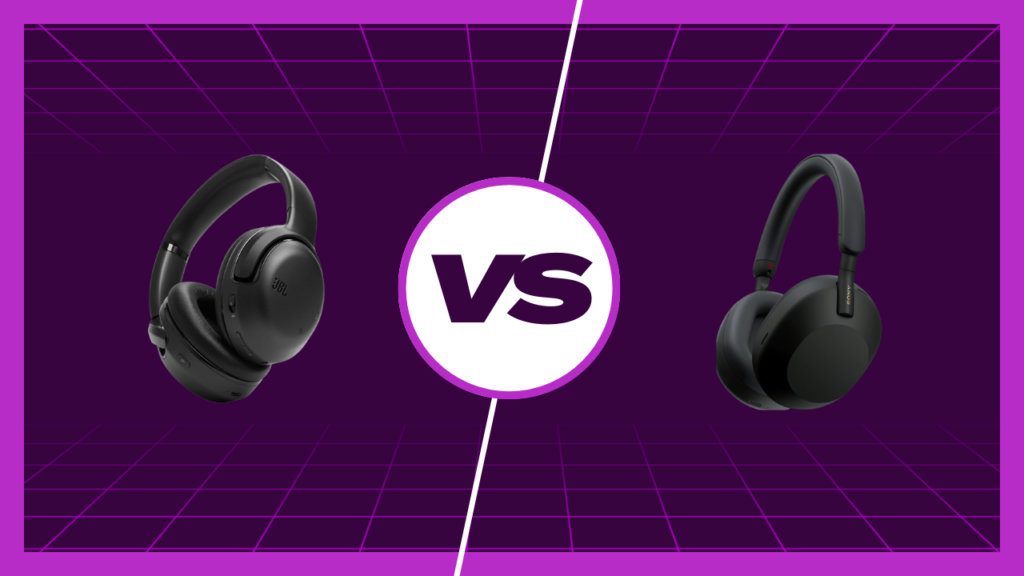"This post contains affiliate links. As an Amazon Associate, I earn from qualifying purchases."
Last Updated on March 9, 2024 by Rifthy
Noise cancelling headphones have become increasingly popular over the past few years, with more and more options hitting the market. Two of the most popular models right now are the JBL Tour One M2 and Sony WH-1000XM5. But which one is actually worth your hard-earned money?

In this in-depth comparison review, we’ll look at the key features, design, sound quality, noise cancellation, battery life, app support, and more to help you decide which premium noise cancelling headphones are the better buy.
Discussed Topics
Overview of JBL Tour One M2 vs Sony WH-1000XM5
| Price | $299 | $399 |
| Noise Cancellation | Adaptive ANC, up to 40 hours battery with ANC on | Industry leading ANC, up to 30 hours battery with ANC on |
| Sound Quality | Lively, brighter default sound with custom EQ options | Clearer mids and highs with some emphasis on bass |
| Design and Comfort | Comfortable with oval earcups, foldable | Very comfortable, non-foldable |
| Call Quality | Good noise reduction but slightly muffled voice | Excellent noise reduction and voice clarity |
| App Support | Bluetooth multipoint, sound customization, touch control options | Bluetooth multipoint, spatial audio, EQ customization |
Noise Cancellation Performance
One of the main reasons anyone buys premium noise cancelling headphones is for the ANC performance. Both JBL and Sony deliver excellent active noise cancellation, but Sony still has a slight edge.
The Sony WH-1000XM5 features industry-leading noise cancellation powered by their new QN1 processor and eight microphones that can detect and cancel out more ambient sounds. Sony’s ANC algorithm automatically adapts based on your activity as well – whether sitting, walking, on transport, etc.
In our testing, the Sony cans suppressed low, mid and high frequencies just a bit better than the JBL, letting in less ambient noise overall. They have great noise blocking capabilities even in noisy environments like busy cafes or traffic.
- Sony ANC rating: Tier S
The JBL Tour One M2 aren’t far behind though, using their Smart Active Noise Cancellation with four mics to adaptively adjust the ANC strength based on your surroundings. JBL’s adaptive tech works quite well to block constant noises like airplane engines.
In direct comparisons, the JBL allowed in a little more ambient sound across the frequency range than the Sony. But it’s not a huge difference, and overall the JBL still provides great noise cancellation.
- JBL ANC rating: Tier A
Both pairs also offer useful transparency/ambient sound modes. JBL has TalkThru to let in voices and sounds for quick conversations. Sony’s Ambient Sound Control lets you adjust how much external sound gets through.
For the most effective real-world noise cancelling though, the Sony WH-1000XM5 take the win. But the JBL aren’t far off for $100 less.
Design and Comfort
In terms of design and wearing comfort, both the Sony and JBL deliver.
The JBL Tour One M2 feature oval shaped ear cups inspired by Bose, using soft padding that feels comfortable for long listening sessions. The headband is nicely cushioned as well.
They have a very sturdy yet flexible build, with smooth ratchets on the headband for adjustment. The headphones are foldable too, great for packing them up in the included hard shell travel case.
We like the tactile, easy to press power and pairing button on the JBL. The touch controls work okay, but can sometimes get accidental taps which is annoying.
- JBL comfort rating: Excellent
The Sony WH-1000XM5 have a sleek, lightweight design with well-padded circular earcups that are super soft. The synthetic leather stays cool even during longer use.
The headband uses a gapless structure with less clamping force, and smooth slides for adjustment. Sony improved the earcup and headband padding on these compared to the XM4.
While not foldable, the Sony still come with a sturdy carrying case to protect them. The touch controls work flawlessly and you can disable them if needed.
- Sony comfort rating: Excellent
For comfort, both deliver premium experiences and should be great for long listening sessions. The JBL foldability gives them a small advantage for portability.
Call Quality Performance
Call quality is another important consideration, especially if you’ll be using these headphones for phone calls often.
The Sony WH-1000XM5 have excellent call quality thanks to Precise Voice Pickup technology using four mics and AI processing. Noise reduction works very well, leaving your voice clear and natural sounding for the other person.
In head-to-head tests, Sony’s mic quality resulted in better clarity compared to the JBL. Wind noise handling was stellar too.
- Sony call quality rating: Tier S
The JBL Tour One M2 also use four microphones to block out ambient noise during calls, along with noise and echo cancelling tech.
While noise reduction is decent, in our tests JBL’s mic quality was a bit more muffled compared to the Sony. It worked fine, but your voice didn’t come through quite as clear.
- JBL call quality rating: Tier A
For best in class call performance, the Sony WH-1000XM5 deliver noticeably better results. But the JBL aren’t bad for phone calls by any means.
Sound Quality
Sound quality is subjective, but here’s how these two pairs of premium headphones compare:
The JBL Tour One M2 have a lively, brighter default sound signature right out of the box. The higher frequencies like cymbals have nice sparkle and clarity.
Acoustic guitars sound spacious, with decent separation from the mids and smooth non-overbearing bass. It’s a fun, energetic sound.
JBL includes several EQ presets and custom options like Personi-Fi hearing calibration for more personalized sound.
- JBL sound rating: Lively, clear
The Sony WH-1000XM5 have a more neutral-leaning default sound, not as bright as the JBLs. The mids and highs are very clear, but Sony does put some extra emphasis on the lower frequencies.
Bass has nice sub-bass extension while voices are smooth and natural. Hi-res LDAC support makes the highs sound crisper.
Sony provides way more sound customization via EQ presets, Clear Bass slider, and 360 Spatial Audio.
- Sony sound rating: Clear, bass prominent
Overall, the JBL wins out for pure sound quality, providing great clarity across mids and highs. But Sony gives you more ways to tweak the sound to your liking. Both deliver great audio that can be customized to suit your preferences.
Battery Life
Battery performance is crucial for wireless headphones you’ll be using on the go. Both models deliver excellent battery life.
The JBL Tour One M2 is rated for 30 hours of listening time with ANC turned on. In our real-world tests we got close to 41 hours of playtime at medium volumes before needing to recharge.
That’s an insane amount of usage before needing to top up the battery. Even heavy users can go days without plugging these in.
The Sony WH-1000XM5 are officially rated for 30 hours as well with ANC on. In testing we managed to achieve around 32 hours of listening with ANC enabled before the battery depleted.
While not as long as the JBL, that’s still an excellent result that translates to full work weeks of use before recharging.
Quick charging is fast on both too – 10 minutes gives you around 4+ hours of listening time.
For battery performance, the JBL Tour One M2 are the clear winners, with almost 10 extra hours of playtime than Sony in real-world usage.
App Support and Connectivity
The companion apps for each headphones unlock adjustable features and settings beyond basic operation.
The JBL Headphones app provides a user-friendly experience, with all key settings accessible from a single page. Handy options include:
- Noise cancelling modes
- Ambient Aware and TalkThru
- Touch control customization
- Virtual Assistant access
- Sound EQ presets
- Personi-Fi hearing calibration
- Max volume limiter
- Firmware updates
Bluetooth multipoint is supported for easy switching between two devices. The pairing process is quick and simple.
The Sony Headphones Connect app is more complex, with some settings buried in sub-menus. But it does enable tons of customization like:
- EQ and 360 Spatial Audio
- Ambient Mode levels
- Adaptive Sound modes
- Call quality adjustments
- Advanced features like LDAC, DSEE, and Auto Play/Pause
- Find My Headphones locating
- Firmware updates
Multipoint Bluetooth allows connection to two devices simultaneously. The pairing process involves a few extra steps.
Both apps work well to enable personalization, but Sony’s feels denser. JBL strikes a better balance of useful features without going overboard.
The Verdict: Sony WH-1000XM5 Are the Better Buy
Based on all the factors compared, the Sony WH-1000XM5 are the better buy overall:
- Their noise cancelling performance is a step above the JBL, making them the ideal choice for frequent fliers or commuters
- Call quality is simply better on the Sony too
- The sound quality provides gorgeous clarity across all frequencies
- Comfort, controls and battery life go toe-to-toe with the JBL
The main advantages of the JBL Tour One M2 are:
- The lower $299 price tag
- Lighter and more comfortable design for some
- Superb 41+ hour battery life
- Slightly better default sound tuning
| Price | $299 | $399 |
| Noise Cancellation | Adaptive ANC, up to 40 hours battery with ANC on | Industry leading ANC, up to 30 hours battery with ANC on |
| Sound Quality | Lively, brighter default sound with custom EQ options | Clearer mids and highs with some emphasis on bass |
| Design and Comfort | Comfortable with oval earcups, foldable | Very comfortable, non-foldable |
| Call Quality | Good noise reduction but slightly muffled voice | Excellent noise reduction and voice clarity |
| App Support | Bluetooth multipoint, sound customization, touch control options | Bluetooth multipoint, spatial audio, EQ customization |
At the end of the day though, the Sony WH-1000XM5 have the edge for noise cancellation effectiveness and call quality – two of the most important factors.
The $100 premium over the JBL gets you markedly better performance in those crucial areas. Plus, Sony’s sound quality and comfort hold their own against the JBL.
For those reasons, the Sony WH-1000XM5 are worth stretching your budget to buy over the JBL Tour One M2 in our opinion. They deliver a complete package befitting their flagship status.
But if you want to save $100 and don’t mind slightly worse ANC, the JBL are still a compelling option. You still get surprisingly good performance for hundreds less.
Hopefully this detailed comparison has helped you decide which of these wireless noise cancelling headphones better meets your needs and budget! Let us know if you have any other questions.
